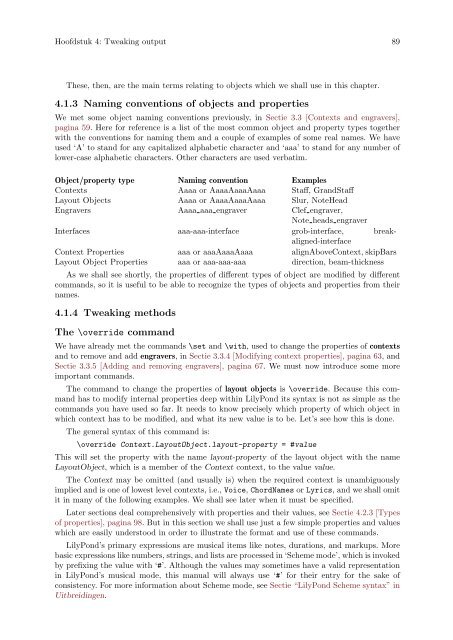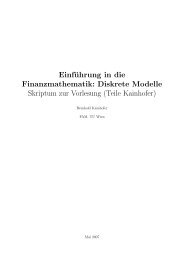LilyPond Beginnershandleiding
LilyPond Beginnershandleiding
LilyPond Beginnershandleiding
You also want an ePaper? Increase the reach of your titles
YUMPU automatically turns print PDFs into web optimized ePapers that Google loves.
Hoofdstuk 4: Tweaking output 89<br />
These, then, are the main terms relating to objects which we shall use in this chapter.<br />
4.1.3 Naming conventions of objects and properties<br />
We met some object naming conventions previously, in Sectie 3.3 [Contexts and engravers],<br />
pagina 59. Here for reference is a list of the most common object and property types together<br />
with the conventions for naming them and a couple of examples of some real names. We have<br />
used ‘A’ to stand for any capitalized alphabetic character and ‘aaa’ to stand for any number of<br />
lower-case alphabetic characters. Other characters are used verbatim.<br />
Object/property type Naming convention Examples<br />
Contexts Aaaa or AaaaAaaaAaaa Staff, GrandStaff<br />
Layout Objects Aaaa or AaaaAaaaAaaa Slur, NoteHead<br />
Engravers Aaaa aaa engraver Clef engraver,<br />
Note heads engraver<br />
Interfaces aaa-aaa-interface grob-interface, breakaligned-interface<br />
Context Properties aaa or aaaAaaaAaaa alignAboveContext, skipBars<br />
Layout Object Properties aaa or aaa-aaa-aaa direction, beam-thickness<br />
As we shall see shortly, the properties of different types of object are modified by different<br />
commands, so it is useful to be able to recognize the types of objects and properties from their<br />
names.<br />
4.1.4 Tweaking methods<br />
The \override command<br />
We have already met the commands \set and \with, used to change the properties of contexts<br />
and to remove and add engravers, in Sectie 3.3.4 [Modifying context properties], pagina 63, and<br />
Sectie 3.3.5 [Adding and removing engravers], pagina 67. We must now introduce some more<br />
important commands.<br />
The command to change the properties of layout objects is \override. Because this command<br />
has to modify internal properties deep within <strong>LilyPond</strong> its syntax is not as simple as the<br />
commands you have used so far. It needs to know precisely which property of which object in<br />
which context has to be modified, and what its new value is to be. Let’s see how this is done.<br />
The general syntax of this command is:<br />
\override Context.LayoutObject.layout-property = #value<br />
This will set the property with the name layout-property of the layout object with the name<br />
LayoutObject, which is a member of the Context context, to the value value.<br />
The Context may be omitted (and usually is) when the required context is unambiguously<br />
implied and is one of lowest level contexts, i.e., Voice, ChordNames or Lyrics, and we shall omit<br />
it in many of the following examples. We shall see later when it must be specified.<br />
Later sections deal comprehensively with properties and their values, see Sectie 4.2.3 [Types<br />
of properties], pagina 98. But in this section we shall use just a few simple properties and values<br />
which are easily understood in order to illustrate the format and use of these commands.<br />
<strong>LilyPond</strong>’s primary expressions are musical items like notes, durations, and markups. More<br />
basic expressions like numbers, strings, and lists are processed in ‘Scheme mode’, which is invoked<br />
by prefixing the value with ‘#’. Although the values may sometimes have a valid representation<br />
in <strong>LilyPond</strong>’s musical mode, this manual will always use ‘#’ for their entry for the sake of<br />
consistency. For more information about Scheme mode, see Sectie “<strong>LilyPond</strong> Scheme syntax” in<br />
Uitbreidingen.



